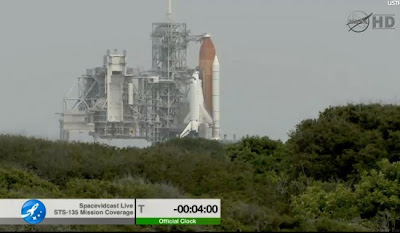My internship with Geekosystem is coming to its end, but its time for another link roundup of my favorite science posts. I’ve been writing a lot of folk art posts lately (somehow that is the beat I’ve gotten myself on) but there have been some really interesting science developments in the past few weeks, especially with regard to goings on in space. Also, for your viewing pleasure here is a video from one of my posts that a commenter called “pure win.” I think so, because on a scale of one to adorable, this is off the charts, and it doesn’t even have any puppies in it.
MIT Researchers Announce Broad Spectrum Treatment For Viral Infections – This research has the potential to make a profound impact on the treatment of viral infections (from colds to hemorrhagic fever) if it is able to be transfered from human cells in the lab, to real humans. It uses the way that viruses replicate by taking over a cell against it, to destroy cells infected with the virus.
Microbots Use Magnetic Forces To Swim And Do Some Heavy Lifting – The post was based on two videos of what really look like just a collection of particles swimming around and moving small objects. The particle bunches are actually microbots, that have some pretty impressive capabilities.
NASA Proves Building Blocks Of DNA Come From Space – I got myself in some trouble with a commenter on this one for the word “prove” in the title. It was a choice to use the word prove in a science post. I used it in the headline in a way that I think is fair, but I got told it sounded like a tabloid, what do you think?
More Dwarf Planets Found In Kuiper Belt, Pluto In Good Company But Still Not A Planet – When Pluto was demoted from planet to dwarf planet a lot of people started to question what makes something a planet in the first place. These newly discovered dwarf planets meet a few of the criteria, but like Pluto, fall short of planethood.
Study: Stem Cells Used To Make Sperm, Then Used To Make Mouse Babies For The First Time – Adding to the amazing list of what scientists have done with stem cells, for the first time they have created sperm cells that resulted in successful offspring that had the ability to reproduce. This could have big impacts for infertility treatments.
Small Shark Can Glow And Become Invisible, Is Not A Mutant – I love doing strange animal posts, this one highlighted a shark that can “cloak” itself and appear invisible based on the way it looks when you view it from below.
Researchers Discover Gene That Causes People To Have No Fingerprints -There are only a few people in the world who don’t have fingerprints. It is a rare condition, and now researchers understand the genetic mutation that causes this disorder.
Scientists Suggest Earth May Once Have Had Two Moons – An interesting theory about how the moon formed suggests that Earth once had two moons, and that one crashed into the other to make our current moon. Its just a theory but there is some compelling evidence in its favor.
NASA To Launch LEGO Figurines Into Space – I totally loved this idea, basically NASA teamed up with LEGO to make three figurines: Juno, Jupiter, and Galileo to celebrate the launch of the Juno Space Probe on its trip to study the planet Jupiter. The figurines are really detailed (and really expensive) but its like every nerd’s dream to have LEGOS in space, right?
Ancient Skulls Sheds Light On How Dogs Became Man’s Best Friend – I didn’t understand the commenter on this post. I only got one and it was about how scientists make sweeping assumptions. Making a hypothesis or suggesting a theory about something based on evidence isn’t the same thing as making assumptions. The research may not be definitive but its not like the researchers were just making stuff up either.
Researchers Find Elusive Oxygen Molecules In Space – We’ve always been taught that there is no oxygen in space, which is why astronauts need those fancy helmets. But, researchers have found oxygen molecules in space. Now its not the same as having an atmosphere like ours with oxygen you can breathe, but its still pretty cool that the molecules were there at all.
Survey Method Shows That A Throw Of The Dice Makes People More Honest – I got a great email from the researcher on this study saying that I’d done a good job capturing it, it totally made my day. This was a really interesting study that showed if people have some kind of an out or a fail safe they are more likely to tell the truth, and it can be useful for gathering data about things people would rather not talk about, like illegal poaching.
Gene For Proteus Syndrome, Cause Of The “Elephant Man,” Found – Proteus Syndrome is a poorly understood disorder that causes tissues to swell so that people appear completely disfigured. For the first time researchers have identified the rare genetic mutation that leads to this disorder.
New Treatment For Hereditary Blindness Is First Drug To Restore Vision – I loved the commenters on this post, it was probably the one post all summer that made me really happy when I read the comments. Both comments I got were from people who either have or know someone with the disease, thanking me for the post. That was really awesome.
Researchers Create Glowing Dog That Can Be Turned On And Off – Researchers genetically altered a dog so that it would glow in the dark. I didn’t really understand the point, since it was an incredibly expensive process it isn’t going to catch on for any kind of commercial purpose and its unlikely to have much of a role in research.
Federal Funding For Human Embryonic Stem Cell Research Ruled Legal – In what is seemingly the final nail in the coffin for this legal challenge to federal funding for human embryonic stem cell research, lawyers have exploited a hole in the law to allow funding to continue. A good thing for researchers, not so good for people with a religious opposition to this type of research.
First Earth Trojan Asteroid Discovered – A trojan is a certain type of asteroid, and for the first time it was found that there is one around Earth, and yes, it is named after the trojans from the Trojan War. A little bit of history in space.
Mountain Lion Makes Longest Journey Ever Recorded By A Land Mammal – Got myself in trouble with commenters for this title too. Someone had to point out that humans are land mammals as well. Well, indeed they are, but I think it is quite obvious that humans are exempted from setting a longest journey record against any other animals. I thought that went without saying. I guess not, because someone felt the need to say it.
Study: Interrupted Sleep Harms Memory Development – This one is pretty self explanatory from the title. But basically researchers determined that people who have their sleep interrupted have a harder time forming memories, it shows a connection between these two brain functions that could be interesting for further study.
Next Mars Rover Will Climb Sediment Mountain – The space shuttle program might be over, but NASA still has plenty of other active projects that could help us learn more about space. One of these projects is the Mars Rover, which is still out there searching for life on the red planet. The next Mars Rover will explore a sediment mountain that has promising environments for evidence of life.
Atlantis Returns To Earth, Space Shuttle Program Now Over – This post marked the landing of the Space Shuttle Atlantis at the completion of its restocking mission to the International Space Station. This final mission was the last trip of the Space Shuttle program, because NASA wants to focus on other things in the future.
Potential Water Discovered On Mars, Still Not A Sign Of Alien Life – NASA researchers have announced that there is liquid water on the surface, or right below the surface of Mars. The water is most likely a brine (salty) and it is unknown how/if this water could impact the search for evidence of life on Mars.
Neil deGrasse Tyson Will Host Sequel To Carl Sagan’s Cosmos Produced By Seth MacFarlane – The reboot of Sagan’s famous TV series will be run on Fox in primetime. The opinion about this seems to be mostly positive, with everyone just hoping that the project does justice to the original series. The choice of MacFarlane makes some people nervous but here’s to hoping it works out well.
Woman Buys Non-Visible Art For $10,000 – So this isn’t a science post, but it needs a little commentary. The source that I used for my post had the woman in question’s name spelled wrong, it was off by one letter. Now, I’m all for accuracy, if I make a spelling mistake please do tell me so I can fix it. But, I still found it pretty amusing that Ms. Davison felt the need not only to comment on the post about wanting her name fixed, but also followed me (then proceeded to unfollow) on twitter so that she and a friend could tweet at me about the error. I have no idea why someone would try so hard to make sure their name was spelled right in a post that openly mocks them and the absolutely ridiculous way they wasted ten grand, but it was pretty important to her. So, I made the change and now I and the commenters on the post can mock her openly with the correct spelling.
***
When I first started this internship I said that I was afraid of the commenters and they made me feel really bad about myself. They still do, if I’m in a bad mood/frame of mind when I start reading comments that rip on every aspect or even just the smallest aspects of a post it makes me sad. I’m still learning which comments to take to heart and which to just write off. I wish I had time to go into all of the detail some of these topics deserve but most of these write ups are under 500 words and some of the context is going to get lost.
It is not an excuse for mistakes, but some of the nitpickers need to keep in mind that Geekosystem is a blog, not a peer reviewed journal. I am not a peer reviewer, I don’t have a science degree and I can’t always call bullshit on a study I don’t know a lot about or don’t have access to the paper through the pay wall system. Sometimes I can call bullshit right off the bat, and when I can, I do. It is just frustrating sometimes to feel like I don’t really get high traffic posts that are well received. We’ll see what this last week at Geekosystem has in store.









